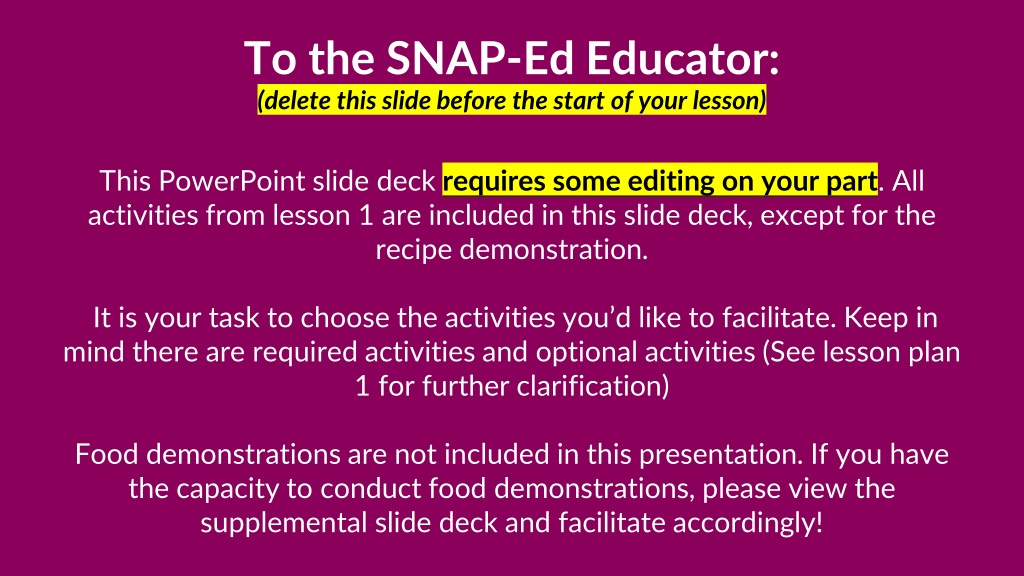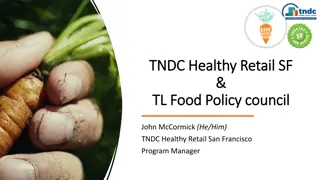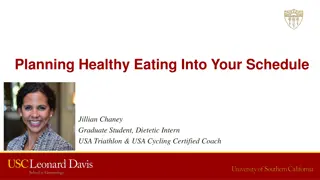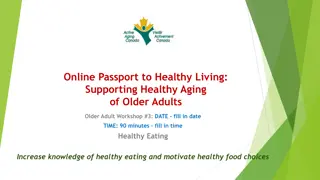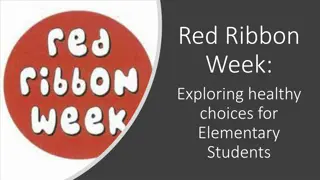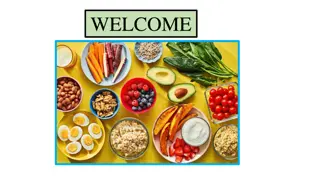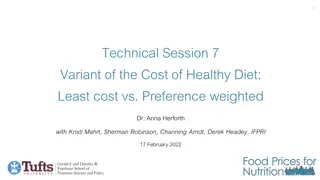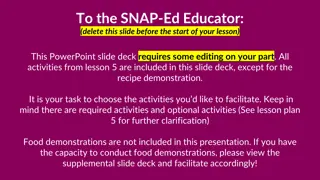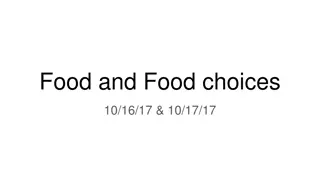Food Smarts Lesson 1: Setting the Stage for Healthy Choices
Engage in interactive activities to enhance your kitchen safety knowledge and learn how to read a recipe. Explore concepts of kitchen safety and complete activities like Taste Test and Kitchen Scavenger Hunt to reinforce your understanding. Join the discussion on what it means to be safe while cooking and discover essential safety rules for the kitchen.
Download Presentation

Please find below an Image/Link to download the presentation.
The content on the website is provided AS IS for your information and personal use only. It may not be sold, licensed, or shared on other websites without obtaining consent from the author. Download presentation by click this link. If you encounter any issues during the download, it is possible that the publisher has removed the file from their server.
E N D
Presentation Transcript
To the SNAP-Ed Educator: (delete this slide before the start of your lesson) This PowerPoint slide deck requires some editing on your part. All activities from lesson 1 are included in this slide deck, except for the recipe demonstration. It is your task to choose the activities you d like to facilitate. Keep in mind there are required activities and optional activities (See lesson plan 1 for further clarification) Food demonstrations are not included in this presentation. If you have the capacity to conduct food demonstrations, please view the supplemental slide deck and facilitate accordingly!
In accordance with Federal law and U.S. Department of Agricultures policy, this institution is prohibited from discriminating on the basis of race, color, national origin, sex, age, religion, political beliefs, or disability.
Food Smarts Lesson 1 Setting the Stage for Healthy Choices 3
Please rename yourself what you would like to be called during class. Welcome + Tech Check Can you mute/unmute, show video and use the chat box? Please turn on video if possible. 4
What to Expect Series of 6 classes Increase your knowledge and provide tools to help you: Make healthy food and beverage choices Incorporate physical activity into your daily life Interactive activities What to Expect 5
Go to the link shared with you I will read the questions and answers aloud Answer as best you can! Pre -Survey 6
Today discussion: Kitchen Safety and How to Read a Recipe Materials needed: Food or Drink for the Taste Test Kitchen Safety worksheet Overview of Class 7
1. What does it mean to be safe while cooking in the kitchen? 2. What are some safety rules for the kitchen? Kitchen Safety 10
KITCHEN SAFETY Be sanitary! Always use clean hands. Wash them with soap and warm water for at least 20 seconds. Always clean items that were in contact with raw meats and eggs immediately after using. Don t put cooked food on a plate or surface that had raw foods! Kitchen Safety 11
KITCHEN SAFETY Keep ______ away from small children Have an _____ around to supervise Make sure all _______ on pots and pans are turned in this avoids accidentally knocking anything over. Cook hot soup or hot food on a __________ if possible. Avoid ______mixing spoons or fingers sample when it is done cooking, or use a clean spoon each time. knives adult handles back burner licking Keep _________appliances away from water. electronic Kitchen Safety 12
Handwashing: with soap and warm water for 20 seconds. Clean up: counters, dishes, and ingredients, before and after cooking. Keep electronics away from water. Sample safely: Taste food only when it is done cooking, using a clean spoon each time. Have supervision: Keep knives away from small children; have an adult around to supervise. Kitchen Safety 13 Kids Workbook p. 12
What do you hope to learn in this class? Closing Question 15
Recipes to try this week: Spiced Trail Mix Fruit Smoothie Thank You and see you next week! 16
In accordance with Federal law and U.S. Department of Agricultures policy, this institution is prohibited from discriminating on the basis of race, color, national origin, sex, age, religion, political beliefs, or disability.
In accordance with Federal law and U.S. Department of Agriculture (USDA) civil rights regulations and policies, this institution is prohibited from discriminating on the basis of race, color, national origin, sex, religious creed, disability, age, political beliefs, or reprisal or retaliation for prior civil rights activity. To file a program discrimination complaint, a complainant should complete a Form AD-3027, USDA Program Discrimination Complaint Form, which can be obtained online at https://www.ascr.usda.gov/sites/default/files/ USDA-OASCR%20P-Complaint-Form-0508-0002- 508-11-28- 17Fax2Mail.pdf, from any USDA office, by calling (866) 632-9992, or by writing a letter addressed to USDA. The letter must contain the complainant s name, address, telephone number and a written description of the alleged discriminatory action in sufficient detail to inform the Assistant Secretary for Civil Rights (ASCR) about the nature and date of an alleged civil rights violation. The completed AD-3027 form or letter must be submitted to USDA by: Mail: U.S. Department of Agriculture Office of the Assistant Secretary for Civil Rights 1400 Independence Avenue, SW Washington, D.C. 20250-9410; or Fax: (833) 256-1665 or (202) 690-7442; Email: program.intake@usda.gov. This institution is an equal opportunity provider.
Conforme a la ley federal y las polticas y regulaciones de derechos civiles del Departamento de Agricultura de los Estados Unidos (USDA), esta instituci n tiene prohibido discriminar por motivos de raza, color, origen nacional, sexo, credo religioso, discapacidad, edad, creencias pol ticas, venganza o represalia por actividades realizadas en el pasado relacionadas con los derechos civiles. Para presentar una queja por discriminaci n en el programa, el reclamante debe completar un formulario AD-3027, Formulario de queja por discriminaci n del programa del USDA, que se puede obtener en l nea, en https://www.ascr.usda.gov/sites/default/files/ USDA-OASCR%20P- Complaint-Form-0508-0002-508-11-28- 17Fax2Mail.pdf, en cualquier oficina del USDA, llamando al (866) 632-9992, o escribiendo una carta dirigida al USDA. La carta debe contener el nombre, la direcci n y el n mero de tel fono del reclamante, y una descripci n escrita de la supuesta acci n discriminatoria con suficiente detalle para informar al Subsecretario de Derechos Civiles (ASCR, por sus siglas en ingl s) sobre la naturaleza y la fecha de la presunta violaci n de los derechos civiles. La carta o el formulario AD-3027 completado debe enviarse al USDA por medio de: Correo postal: U.S. Department of Agriculture Office of the Assistant Secretary for Civil Rights 1400 Independence Avenue, SW Washington, D.C. 20250-9410; o Fax: (833) 256-1665 o (202) 690-7442; Correo electr nico: program.intake@usda.gov. Esta instituci n ofrece igualdad de oportunidades.
